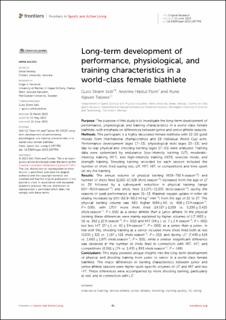| dc.description.abstract | Purpose: The purpose of this study is to investigate the long-term development of performance, physiological, and training characteristics in a world-class female biathlete, with emphasis on differences between junior and senior athlete seasons.
Methods: The participant is a highly decorated female biathlete with 22 (10 gold) medals from international championships and 28 individual World Cup wins. Performance development (ages 17–33), physiological tests (ages 22–33), and day-to-day physical and shooting training (ages 17–33) were analyzed. Training data were systemized by endurance [low-intensity training (LIT), moderate-intensity training (MIT), and high-intensity training (HIT)], exercise mode, and strength training. Shooting training recorded for each session included the number of shots fired during rest, LIT, MIT, HIT, or competitions and time spent on dry fire training.
Results: The annual volume of physical training (409–792 h·season−1) and number of shots fired (1,163–17,328 shots·season−1) increased from the age of 17 to 28 followed by a subsequent reduction in physical training (range 657–763 h·season−1) and shots fired (13,275–15,355 shots·season−1) during the seasons of peak performance at ages 31–33. Maximal oxygen uptake in roller ski skating increased by 10% (62.9–69.2 ml·kg−1·min−1) from the age of 22 to 27. The physical training volume was 48% higher (694 ± 60 vs. 468 ± 23 h·season−1, P = .030), with 175% more shots fired (14,537 ± 1,109 vs. 5,295 ± 3,425 shots·season−1, P = .016) as a senior athlete than a junior athlete. In the physical training, these differences were mainly explained by higher volumes of LIT (602 ± 56 vs. 392 ± 22 h·season−1, P = .032) and MIT (34 ± 1 vs. 7 ± 2 h·season−1, P = .001) but less HIT (27 ± 1 vs. 42 ± 3 h·season−1, P = .006) as a senior than a junior. In line with this, shooting training as a senior included more shots fired both at rest (5,035 ± 321 vs. 1,197 ± 518 shots·season−1, P = .011) and during LIT (7,440 ± 619 vs. 2,663 ± 1,975 shots·season−1, P = .031), while a smaller insignificant difference was observed in the number of shots fired in connection with MIT, HIT, and competitions (2,061 ± 174 vs. 1,435 ± 893 shots·season−1, P = .149).
Conclusions: This study provides unique insights into the long-term development of physical and shooting training from junior to senior in a world-class female biathlete. The major differences in training characteristics between junior and senior athlete seasons were higher sport-specific volumes of LIT and MIT and less HIT. These differences were accompanied by more shooting training, particularly at rest, and in connection with LIT. | en_US |

